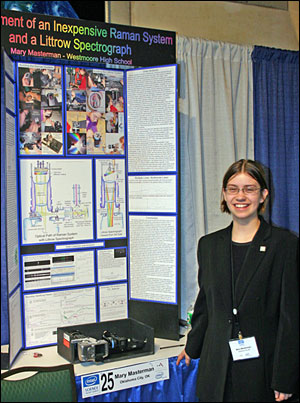
Teen's Spectrograph Wins $100K Science Scholarship
WASHINGTON, March 15, 2007 -- A 17-year-old girl who built an accurate spectrograph that identifies the specific characteristics, or "fingerprints," of different kinds of molecules was named the top winner of the Intel Science Talent Search award on Tuesday, receiving a $100,000 scholarship.
 Mary Masterman of Oklahoma City received the top prize for assembling a spectrograph, which can cost as much as $100,000, at home for only $300 using a laser, lenses, some aluminum tubing and a camera. Spectrographs are designed to disperse light into individual wavelength components -- the light "spectrum" -- so each wavelength can be recorded and analyzed. They have applications in astronomy, biomedicine, explosives detection, and in authenticating artwork.
Mary Masterman of Oklahoma City received the top prize for assembling a spectrograph, which can cost as much as $100,000, at home for only $300 using a laser, lenses, some aluminum tubing and a camera. Spectrographs are designed to disperse light into individual wavelength components -- the light "spectrum" -- so each wavelength can be recorded and analyzed. They have applications in astronomy, biomedicine, explosives detection, and in authenticating artwork.
"Mary found that machining the parts and aligning the optics (lenses from a microscope and a camera) were particularly challenging. Her Littrow spectrograph splits light, like a prism, and uses a camera to record the resulting Raman spectra -- a specific vibrational fingerprint of the molecular compound being investigated. Using a laser as her light source, Mary tested several household objects and solvents and compared her results to published wave numbers. Despite the shortcomings of the inexpensive laser, she found she could make relatively accurate wavelength measurements with her homemade device," Intel Corp. said in a statement.
Mary Masterman, 17, of Oklahoma City, displays her top prize-winning research at the National Academy of Sciences. Mary placed first among 1705 applicants to win a $100,000 scholarship from the Intel Foundation. Mary built an accurate spectrograph that identifies the specific characteristics of different kinds of molecules. Spectrographs have wide applications in research and industry and can cost as much as $100,000. Mary’s invention cost approximately $300. (Photo: Intel Corp.)
Masterman is the author of a poster presentation about the Raman effect at an American Astronomical Society conference and winner of numerous science honors, including placing first for the 2006 National Young Astronomer Award. She is ranked first of 658 at Westmoore High School and said she hopes to enroll at the Massachusetts Institute of Technology or California Institute of Technology.
More than 1700 high school seniors nationwide entered Intel STS this year, which set a record, Intel said. Of those, 300 were chosen as semifinalists in January, and then 40 finalists were invited to Washington to compete for the top 10 awards, which were announced this week.
STS, now in its 66th year, counts among its alumni six Nobel laureates, three National Medal of Science winners, 10 MacArthur Foundation fellows and two Fields Medalists.
Masterman received her award from Intel Chairman Craig Barrett during a banquet Tuesday night. While he said he was impressed with all of the finalists, he said, "I am particularly heartened by the fact that more women were finalists and top 10 winners this year than in any year since Intel assumed the title sponsorship in 1998."
Other top 10 Intel STS winners include: John Pardon, 17, of Chapel Hill, N.C., who received a $75,000 scholarship for solving a classical open problem in differential geometry by showing that a finite-length closed curve in the plane can be made convex in a continuous manner, and without bringing any two points of the curve closer together; Emma Call, 18, of Baltimore, Md., who received a $20,000 scholarship for fabricating 3-D microcubes, which have potential use as drug-delivery devices; and Catherine Schlingheyde, 17, of Oyster Bay, N.Y., who received a $25,000 scholarship for her research on microRNA repression, a basic mechanism that regulates cell function.
Science Service, a nonprofit organization that works to advance the understanding and appreciation of science, has administered the STS since its inception in 1942. For more information, visit: www.sciserv.org
/Buyers_Guide/Intel_Corp/c6919